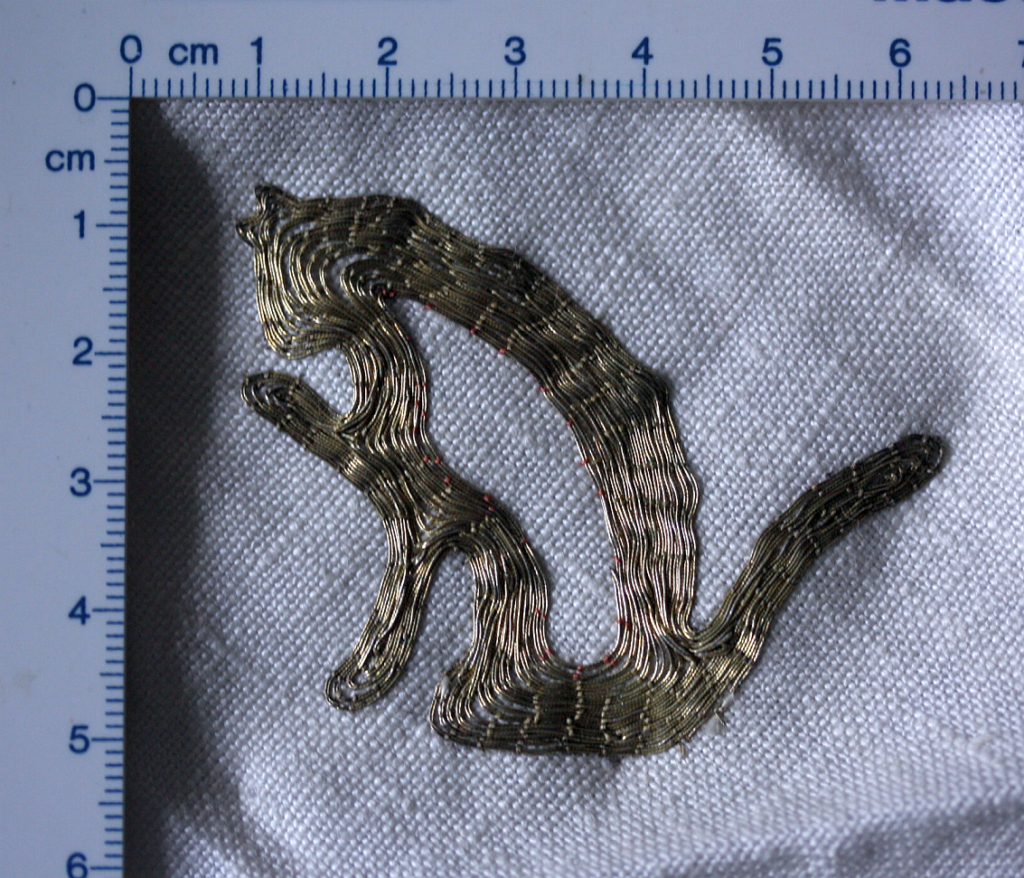Search the Blog
Latest Comments
Beatrix
Experiment!
23. April 2024
The video doesn´t work (at least for me). If I click on "activate" or the play-button it just disapp...
Katrin
Spinning Speed Ponderings, Part I.
15. April 2024
As far as I know, some fabrics do get washed before they are sold, and some might not be. But I can'...
Kareina
Spinning Speed Ponderings, Part I.
15. April 2024
I have seen you say few times that "no textile ever is finished before it's been wet and dried again...
Katrin
How on earth did they do it?
27. März 2024
Ah, that's good to know! I might have a look around just out of curiosity.
I've since learned that w...
Heather Athebyne
How on earth did they do it?
25. März 2024
...though not entirely easy. I've been able to get my hands on a few strands over the years for Geor...
Gold Embroidery Maths.
I've been asked recently about how much gold thread to calculate for covering a given area - so I've taken out my samples and took a look, and did some maths, and maybe that's interesting for you, too.
The gold thread that I have in the shop is about 0,2 mm in diameter - so if we assume that it will be couched down perfectly, one thread right beside the next, and there's no significant gap between threads, 50 threads next to each other are needed to cover a width of one centimeter. For a stripe one centimeter wide and ten centimeters long, accordingly 5 metres of thread are needed - plus a little more, since it's necessary to have a little bit of thread to pull to the back of the fabric.
When I had my gold embroidery starter kit fairly new, I found a volunteer to test it for me, and these are the results of stitching with 5 m of gold thread:
[caption id="attachment_5805" align="alignnone" width="640"] This is how much ground you can cover with 5 m of gold thread.
This is how much ground you can cover with 5 m of gold thread.
That's roughly in the area of the 10 x 1 cm stripe. As you can see in the picture (hopefully - it's really hard to take a good photo of gold embroideries!) there are areas where the threads overlap a little, and areas where there are narrow gaps, and that can even itself out or, if you tend more towards one or the other, it will reduce or extend your covered area slightly.
As to the number of threads lying beside each other, I did some counting on a piece where I had threads couched all in parallel, and I got about 21 to 23 threads on 5 mm - so about 42 to 46 per centimeter. Which is close to the theoretical 50, but not quite there, just like I would have expected.
For calculating thread needs, thus, 50 cm of thread per square centimeter seems to be a good ballpark number - it should give you enough wiggle room to anchor your thread ends and safely cover that area, even if you have a little bit of overlap here or there.
The gold thread that I have in the shop is about 0,2 mm in diameter - so if we assume that it will be couched down perfectly, one thread right beside the next, and there's no significant gap between threads, 50 threads next to each other are needed to cover a width of one centimeter. For a stripe one centimeter wide and ten centimeters long, accordingly 5 metres of thread are needed - plus a little more, since it's necessary to have a little bit of thread to pull to the back of the fabric.
When I had my gold embroidery starter kit fairly new, I found a volunteer to test it for me, and these are the results of stitching with 5 m of gold thread:
[caption id="attachment_5805" align="alignnone" width="640"]
 This is how much ground you can cover with 5 m of gold thread.
This is how much ground you can cover with 5 m of gold thread.That's roughly in the area of the 10 x 1 cm stripe. As you can see in the picture (hopefully - it's really hard to take a good photo of gold embroideries!) there are areas where the threads overlap a little, and areas where there are narrow gaps, and that can even itself out or, if you tend more towards one or the other, it will reduce or extend your covered area slightly.
As to the number of threads lying beside each other, I did some counting on a piece where I had threads couched all in parallel, and I got about 21 to 23 threads on 5 mm - so about 42 to 46 per centimeter. Which is close to the theoretical 50, but not quite there, just like I would have expected.
For calculating thread needs, thus, 50 cm of thread per square centimeter seems to be a good ballpark number - it should give you enough wiggle room to anchor your thread ends and safely cover that area, even if you have a little bit of overlap here or there.
Comments
No comments made yet. Be the first to submit a comment



